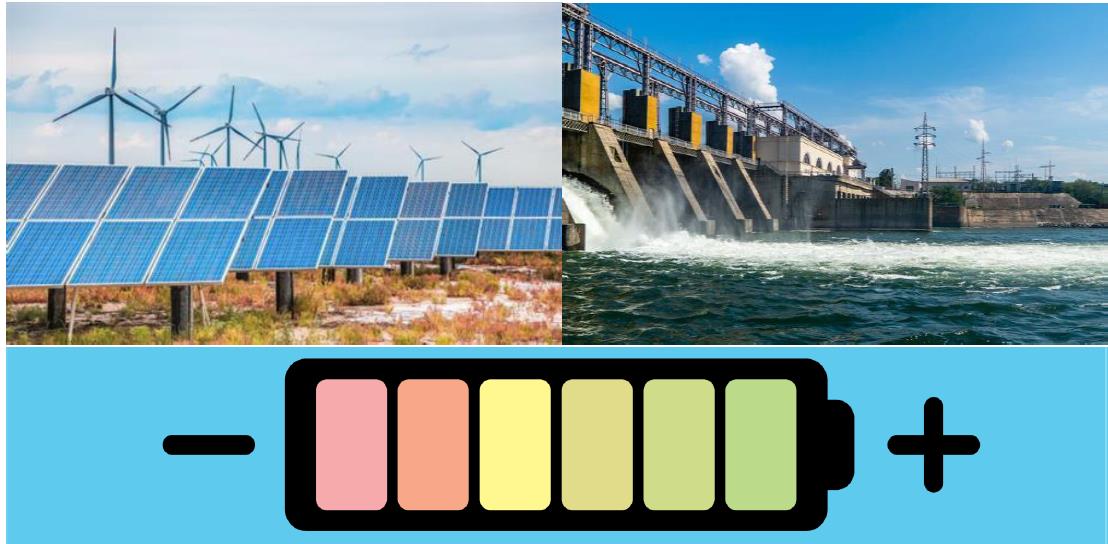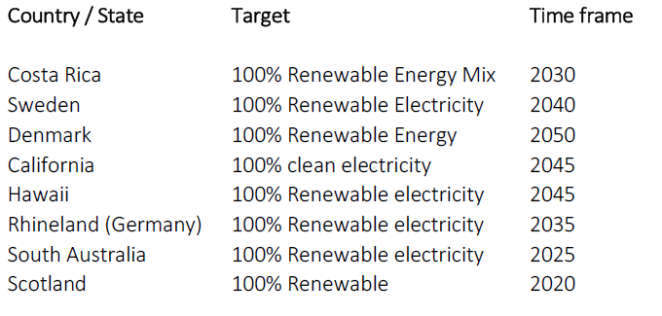Article /
Decarbonizing the Electricity Sector – The Energy Storage Conundrum

Threat of Climate change
The dreadful impact of Climate change is being noticed in a real time and the recent heat waves that several parts of the globe witnessed serve as a grim reminder and a grave warning for more horrific occurrences which would be ruthlessly unbiased, engulfing the whole world. Alongside, the media is rife with reporting and spreading these calamities and bringing the seriousness to the purview of public. Governments across the world have taken serious actions both in terms of policies and committed developments to play its part in containing the greenhouse gas emissions; that ubiquitous element, the uncontrollable extent of which is responsible for the current mess.
One mantra that appears to have found a reasonable acceptance, interest and the curiosity is “grid decarbonizing” an action that signals a shift from traditional fossil fuel driven power plants to renewable technologies that are capable of generating the power without emissions. In nutshell they are termed clean power. The trend appears to have gained enough traction to embolden nations to set a timeframe for achieving 100% clean energy. Some of the countries/states that have committed / already voted a law or in the process of doing so towards decarbonizing the energy sector are listed below.

In addition to the above several countries have also committed to go completely carbon neutral (meaning zero emissions) which automatically implies a deep decarbonization of the electrical energy in addition to other areas such as industries, transportation, agriculture etc.
Some important points to be recognized when it comes to adaptation / resilience are as below.
- The electricity sector is the single largest single source of global greenhouse gas emissions contributing to over 25% . Such a sector should be equipped with tools and policies that increases its resilience to those vulnerabilities associated with climate change.
- Renewable energy creates resilient energy systems in addition to reducing the carbon emissions.
- Energy storage within practical limits supports the energy security and resilience of the community.
- Practical, reasonable and proportional retiring of coal plants and moving to just transition alongside thrust on community engagement and awareness exercises would prepare the community for lesser reliance on coal industry and also help them to acquire greater skills in the field of renewable energy, distributed power, microgrid and energy storages. These reduce disaster risk at a local and specific level for a sustainable society in the long-term.
In summary, the possibility of aternative energy /clean energy sources increases the reliability and resiliency of the local energy system while also increasing economic growth, energy self-sufficiency, energy redundancy, the flexibility of the power system to allow for use of alternative fuels, and the flexibility in the way local energy is managed. Besides fulfilling the resilience objectives, it understandably creates synergy by complimenting the responses of mitigation.
Renewable Energy
Nations have further initiated policy actions deploying the right instruments in order to achieve their targets of clean energy. The choice of renewable energy included a wide array such as wind, solar, hydro, geothermal etc. depending on the geography and ready availability of the resources. A look at various countries that have reached a high level of renewable energy in the energy mix shows that the natural geology of the place has played an important role in choosing the right policy levers.
While it is indeed laudable to see monumental actions towards decarbonizing the world, it is equally essential to introspect the implementation mechanisms to ascertain if they indeed support the long term aspirations which are energy availability, energy security, energy reliability, sustainability and affordability.
Renewable energy sources by very definition are clean and sustainable; however, suffer from the limitations such as reliability, intermittency, capacity, storability and dispatchability . Given the above constraints, there is a strong need to exploit the available renewable energy during the peak times of generation (favorable weather) and further store them (excess energy) in some medium that can be dispatched into actual load centers. Put simply, the purpose of the technology is to store energy for later use instead of the current traditional system in which most electricity must be consumed as soon as it is generated.
There are different types of storage available currently which include pumped-storage, chemical batteries, flywheels, compressed air, thermal etc. Among these, pumped-storage hydroelectricity is the most cost effective one although they are extremely geography dependent meaning it cannot be adapted to any random place or city. In addition to these, several other storage techniques are also being widely researched.
Energy Storage Dilemma
It is important to connect the dots when it comes to holistically visualizing the decarbonization of power sector, renewable energy systems and energy storage as all of them are complimentary to a true fight against climate change. The storage system adopted by a country is a function of the location’s typography. As stated before although there are different types of storages that are technically feasible, the one that has been most widely adopted is the pumped storage system as it is cheaper especially when it comes to large capacities. Taking the example of united states, of the total of 25 GW of operational thermal energy storage, 22.6 GW comprise pumped hydroelectric storage. When considering energy storage, the following should be duly introspected.
- Compulsion to generate excess renewable energy. Renewable technologies by their very nature are seasonal / time based. For instance, solar and wind power ceases in winter or in the absence of wind. It is imperative for the renewable energy plants to far exceed the required peak capacity in order to be able to use this excess energy for storage. Only then would it be able to provide the needed capacity during seasonal dips. The Clean Air Task Force, a Boston-based energy policy think tank, recently found that reaching the 80 percent mark for renewables in California state alone would mean massive amounts of surplus generation during the summer months, requiring 9.6 million megawatt-hours of energy storage. For a target of 100% it would require 36.3 million megawatt-hours.
- Cost burden. Currently Lithium ion technology which is the one that is widely debated is expensive and doesn’t last nearly long enough, limiting the role they can play on the grid. Building the level of renewable generation and storage necessary to reach the nation’s goals would drive up costs exponentially. In the case of California state referred above, the cost of power increases from $49 per megawatt-hour of generation at 50 percent to $1,612 at 100 percent. A study by “Energy & Environmental Science” found that at current prices, a battery storage system for meeting 80% of US electricity demand would cost more than a whopping $2.5 trillion
- Uncertain optimism. There is a general growing optimism that the giant batteries will allow wind and solar power to displace a growing share of fossil-fuel plants. This is far from truth when you realize that the current share of renewable energy is just about 25%.
- Sense of all pervading Perpetuity: It is also widely held notion that the energy storage is a one stop solution for the global energy needs and an effective contributor to fight climate change. While this is a potential weapon, it is not something (or the only thing) that we have to fall back in the current trying situation. Energy storage in general and battery storage in particular should be judiciously explored and used as a peaking strategy while the market progresses towards transforming the base power load to a broader mix of low carbon sources such as nuclear and natural gas.
Into the Future
It is beyond doubt that reducing the GHG emissions is the ONLY way to reverse the devastating trend and bring the planet towards a balance that would allow a sustainable life. IPCC studies clearly indicate that the burning of coal, natural gas, and oil for electricity and heat is the largest single source of global greenhouse gas emissions contributing to over 25% of the global emissions. The logical path dictates that this sector be dealt with utmost assertive priority for radical decarbonization. There are absolutely no two opinions on this issue. However, the way it is pursued requires a deeper introspection.
Renewable energy provides the greatest and perhaps the last large-scale opportunity for the mankind to act. We however need to take cognizance of the limitations of the renewable energy and hence the ground realities when transitioning towards 100% carbon free energy sources.
- Energy Storage. RE requires energy storage to keep the power supply on when the renewable source is unavailable. Currently it comes with huge price task which is unsustainable. Renewable energy road map should be conceptualized with forethought and lot more pragmatism when it comes to energy storage strategies / deployment over a period of time. Energy storage systems wherever deemed to be appropriate should become a central element in energy policy debates across the globe.
- Ongoing Research. Ongoing research on energy storage technologies/ inventions such as aqueous sulphur flow batteries, V2G, are comforting and reassuring; however, they are still in the research and development phase and it would be a while before they successfully transcend to demonstration and to successful deployment. This is a crucial piece that is capable of directing the future of energy storage. Till such time it would be dangerous to bank on these breakthroughs.
- Sustainability. Debates about exiting fossil fuel rapidly and moving into RE domain is not only about jobs and just transition but the viability of the alternative energy over a period of time. This implies that with all the strategies in place, the net cost of clean power should be affordable to the common citizen.
- Alternative strategies. Renewable energy has a long journey before it completely dominates the energy mix. We should be open to assimilating technologies that would help lessen the environmental burden of the existing fossil fuel based power centers. Efforts should multiply on CCS technologies that can even render the current fossil based power stations more environment friendly. One should not ignore the fact that large, flexible coal or natural-gas combined-cycle plants that have been cranking the world enjoy certain features such as reliability, continuity and scalability so as to deliver the output to meet the demand throughout the day.
Summary
Nations voting to achieve carbon neutrality in the power sector tend to rely heavily on RE and the storage in order to achieve its goals. While the effort towards 100% renewable is indeed formidable, one should not be blind to the humongous task of the energy storage required to compliment the system.
Over a period of time when the cost of energy storage drops down radically (fueled by additional breakthroughs on the back of successful research) and it gains the critical mass for scalability, the world would be in a better position to embrace it. Alongside we would witness significant and encouraging results in CCS technologies that would render the few fossil fuel based energy systems cleaner and less harmful. These along with other global actions on energy efficiency, supply & demand side management and the rest would coalesce and gravitate the planet towards that single milestone that we are all aspiring. A better future for the future generation.
